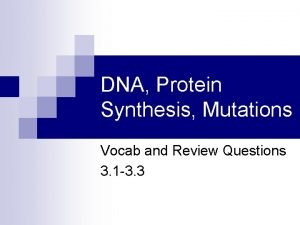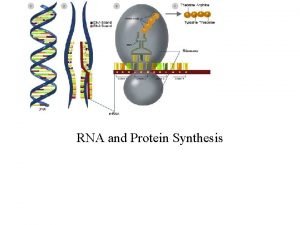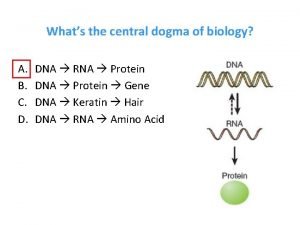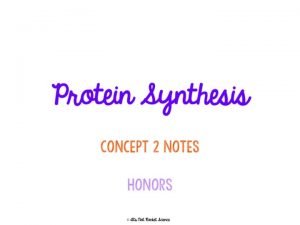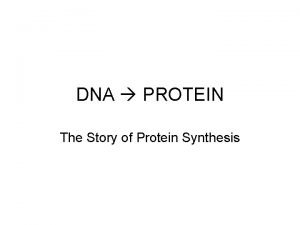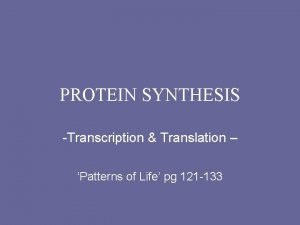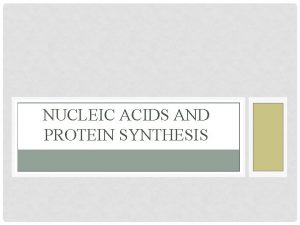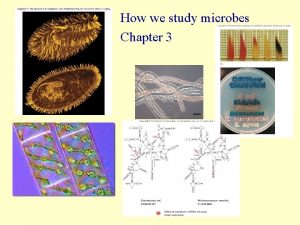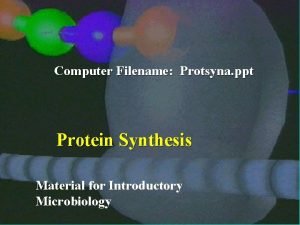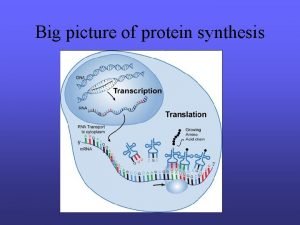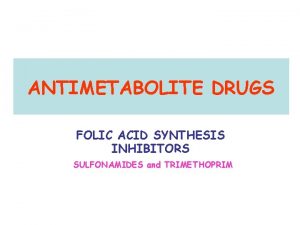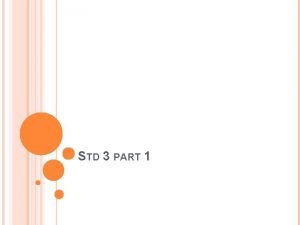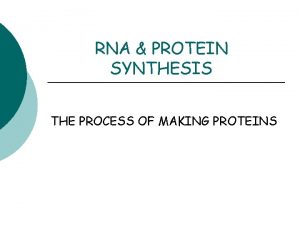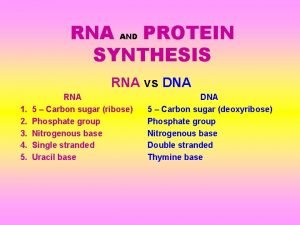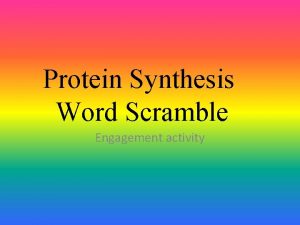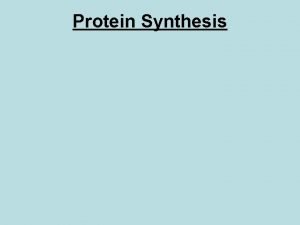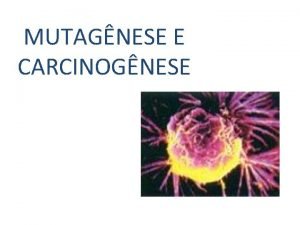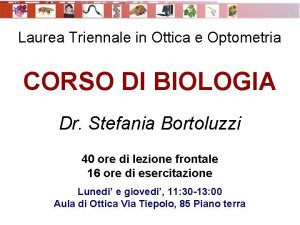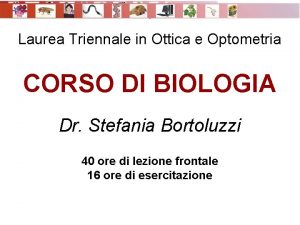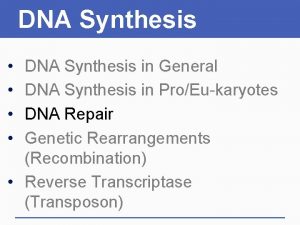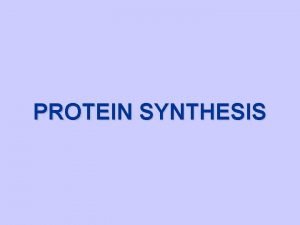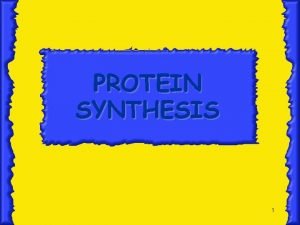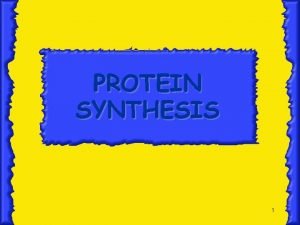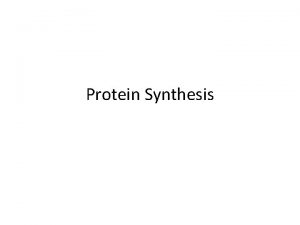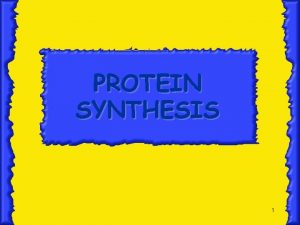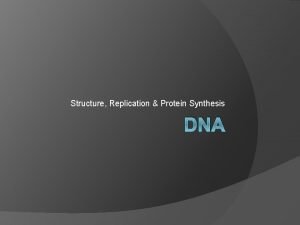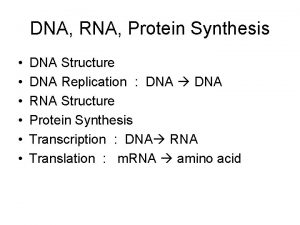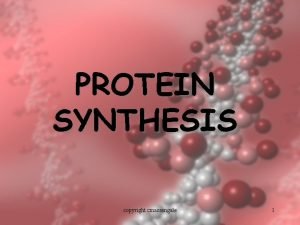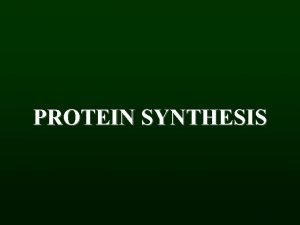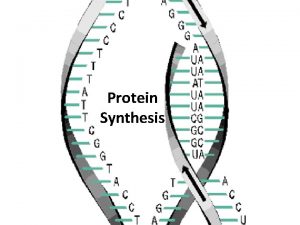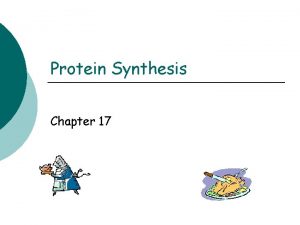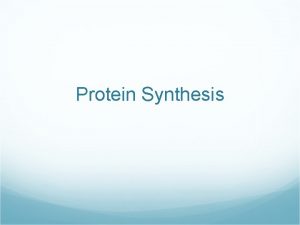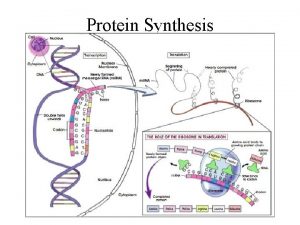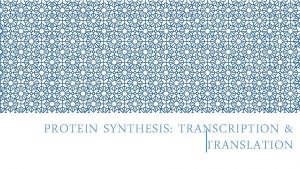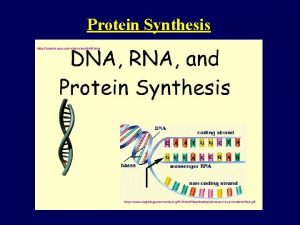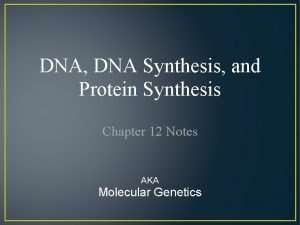DNA Structure and Protein synthesis What is DNA


































- Slides: 34

DNA Structure and Protein synthesis

What is DNA? DNA = deoxyribonucleic acid n Chromosomes are made of DNA n It carries genetic information: controls the activities of cells by providing instructions for making proteins n Every nucleated cell in your body contains DNA. n

Alfred Hersey and Martha Chase Experiment (1952) n n protein coat and the DNA of bacteriophage (virus that attacks bacteria) were marked using radioactive sulphur (35 S) and phosphorus (32 P), bacteriophage DNA (radioactive) moved into the bacterial cells and directed them to produce new bacteriophages (radioactive) protein coating(radioactive) was left outside the cell, new bacteriophages were not radioactive conclusion: DNA, not protein, carries genetic information

Alfred Hersey and Martha Chase Experiment (1952)

Earlier work by a biochemist P. A. Levine n n DNA was made up of nucleotides. Each nucleotide is made up of three parts. 1) A sugar called deoxyribose 2) a phosphate group (phosphoric acid) 3) one of the four nitrogen containing bases (adenine, guanine, thymine and cytosine – A, G, T, C) Levine found that each nitrogen base is attached to a sugar, and each sugar is attached to a phosphate group to form a single nucleotide. Each nucleotide is named for the base it contains.

Nucleotide

Nitrogen Bases

Other studies: nucleotides are joined together to form long chains. n Erwin Chargaff: equal number of adenine and thymine as well as guanine and cytosine. (#A = #T, #G = #C) n

Nucleotide Pairs Percent of Each Base in DNA Samples Source of sample A G C T Human Liver 30. 3 19. 6 19. 9 30. 3 Human Thymus 30. 9 19. 8 29. 4 Wheat plant 27. 3 22. 7 22. 8 27. 1 Bacterium 24. 7 26. 0 25. 7 23. 6

Discovering the Double Helix. Information scientists knew: n n DNA is made up of nucleotides Nucleotides are linked together in a string. In each DNA molecule there is an equal number of A – T and an equal number of G-C If the nucleotides are strung in a straight line, a typical DNA molecule would be over 1 meter long. Somehow it must be compressed.

Rosalind Franklin (1953) n n British crystallographer, was able to photograph molecules using x-rays. (X-ray diffraction) These patterns indicated DNA was like a coil. The DNA molecule had a constant diameter of 2 nm. It did not get wider or narrower in some parts of the molecule.

James Watson and Francis Crick came up with the current model for DNA. They compared it to a spiral staircase. n They called this shape a double helix. They also determined that nitrogen bases were always paired in the same manner. These paired nitrogen bases are called complementary base pairs. (A with T, G with C) n

A and T by 2 H- bonds G and C by 3 H-bonds

Links n n n DNA Structure http: //www. youtube. com/watch? v=qy 8 dk 5 i. S 1 f 0&feature=related http: //www. youtube. com/watch? v=l-hr. Ls 03 Kj. Y DNA Replication http: //www. youtube. com/watch? v=hf. Z 8 o 9 D 1 tus&feature=related http: //www. youtube. com/watch? v=z 685 FFqmrpo&feature=related http: //www. youtube. com/watch? v=AGUu. X 4 PGl. Cc&feature=related RNA synthesis http: //www. youtube. com/watch? v=UXJz. NI_t_r 4 RNA to Protein http: //www. youtube. com/watch? v=NJxobgk. PEAo http: //www. youtube. com/watch? v=983 lhh 20 r. GY

DNA Sequencing n n n Unique genetic information is determined by the sequence of nucleotides. A sequence of A-T-C-G-G-A carries different information from the sequence C-A-G-T-T-A. The closer the relationship between two organisms, the greater the similarities in their DNA sequences. The order of base pairs in a DNA molecule makes up the genetic code of an organism to produce proteins.

Predicting the opposite base sequence n What would be the opposite strand of DNA if the sequence was? n A-T-C-G-A-G-T-T-G

n A-T-C-G-A-G-T-T-G n Opposite strand: T-A-G-C-T-C-A-A-C

What is DNA responsible for? n n n DNA determines how amino acids are strung together and how proteins are made. The sequence of amino acids is determined by the sequence of NUCLEOTIDES in the DNA. A gene is a segment of DNA that controls the production of a protein. The genetic information on DNA must be transcribed to RNA to make proteins.

Protein

Polypeptide Chain n Proteins are made up of 20 kinds of amino acids. For each protein, amino acids are linked together in a certain order. Linked amino acids form long chains called polypeptides, and two or more polypeptides are joined to make a particular protein. Examples of protein: Keratin - nails and hair Insulin – hormone, controls sugar levels. Hemoglobin -in red blood cells Enzymes

Genetic Information must be transcribed from DNA to RNA n n n RNA= ribonucleic acid - contains ribose sugar (one more oxygen than in DNA) - single stranded, - uracil replaces thymine, adenine pairs with uracil, guanine pairs with cytosine (A-U, G-C) - found in the nucleus and the cytoplasm of a cell


Three Types of RNA n 1) messenger RNA (m. RNA): acts as a messenger that carries the DNA information from the nucleus to the ribosomes in the cytoplasm n 2) transfer RNA (t. RNA): delivers amino acids to ribosomes n 3) ribosomal RNA (r. RNA): Binds with proteins to form the ribosomes

Summary 3 nitrogen bases (3 nucleotides) on DNA (ex. GAA) 3 nitrogen bases (3 nucleotides) or a codon on RNA (ex. CUU) 1 amino acid (ex. Leucine) 20 different types of amino acids a polypeptide chain many polypeptide chains protein n


Steps from DNA to Protein: n 1. An enzyme binds to DNA and unzips the two strands. DNA opens like a zipper. n 2. Transcription: Another enzyme attaches nucleotides on one of the two open DNA strands as a template to make an m. RNA strand. n Ex) DNA Strand GCGCGTATGCATTAGTCGT CACGTACATGGTACTGATC A RNA Strand? n n

RNA sequence Ex) DNA Strand n GCGCGTATGCATTAGTCGTCACGTACAT GGTACTGATCA n RNA Strand? (U instead of T) n CGCGCAUACGUAAUCAGCAGUGCAUGUA CCAUGACUAGU same as the opposite DNA strand (nontemplate strand) n

Steps from DNA to Protein: n 3. The m. RNA detaches from the DNA template and moves out of the nucleus. It travels to the ribosomes in the cytoplasm.

Steps from DNA to Protein n 4. Translation: A ribosome attaches to the m. RNA. Each set of 3 bases, known as a CODON, codes for an amino acid. t. RNA brings an amino acid to the ribosome according to the codon on the RNA. Amino acids make up a polypeptide chain. n 5. The polypeptide chain leaves the ribosome and joins with other polypeptide chains. They fold and form a protein.


Codons on RNA n n Start codon - AUG (Methionine) This sequence indicates the FIRST amino acid in the chain that will grow to be a protein. Stop Codon (UAA, UAG, UGA) – indicates that no more amino acids should be added and a particular protein is complete.

The RNA Genetic Code

Q 1. What amino acid does this 3 base sequence (codon) code for? n 1) ACU: threonine n 2) CGA: arginine

Q 2. What codon(s) code for n 1)glycine? GGU, GGC, GGA, GGG 2)leucine? UUA, UUG, CUU, CUC, CUA, CUG
 Dna rna protein synthesis homework #2 dna replication
Dna rna protein synthesis homework #2 dna replication Rna and protein synthesis study guide
Rna and protein synthesis study guide Section 12-3 rna and protein synthesis
Section 12-3 rna and protein synthesis Missense mutation in sickle cell anemia
Missense mutation in sickle cell anemia Protein synthesis and mutations
Protein synthesis and mutations Protein synthesis and mutations
Protein synthesis and mutations Rna transfer
Rna transfer Totipotent cells
Totipotent cells Rna protein synthesis
Rna protein synthesis Protein synthesis restaurant analogy
Protein synthesis restaurant analogy Translation or transcription
Translation or transcription Transcription and translation bbc bitesize
Transcription and translation bbc bitesize Cookie monster analogy
Cookie monster analogy Elongation
Elongation Dna and rna
Dna and rna Protein synthesis
Protein synthesis Protein synthesis
Protein synthesis Protein synthesis story
Protein synthesis story Protein synthesis animation mcgraw hill
Protein synthesis animation mcgraw hill Molecular genetics
Molecular genetics Transcription and translation
Transcription and translation Protein synthesis
Protein synthesis Riosome
Riosome Protein synthesis ppt
Protein synthesis ppt Picture transcription
Picture transcription Paba
Paba Which best summarizes the process of protein synthesis?
Which best summarizes the process of protein synthesis? Concept map of protein synthesis
Concept map of protein synthesis Protein synthesis
Protein synthesis Protein synthesis scramble
Protein synthesis scramble Process of protein synthesis
Process of protein synthesis Cytosio
Cytosio Protein synthesis
Protein synthesis Protein synthesis
Protein synthesis Protein synthesis
Protein synthesis





